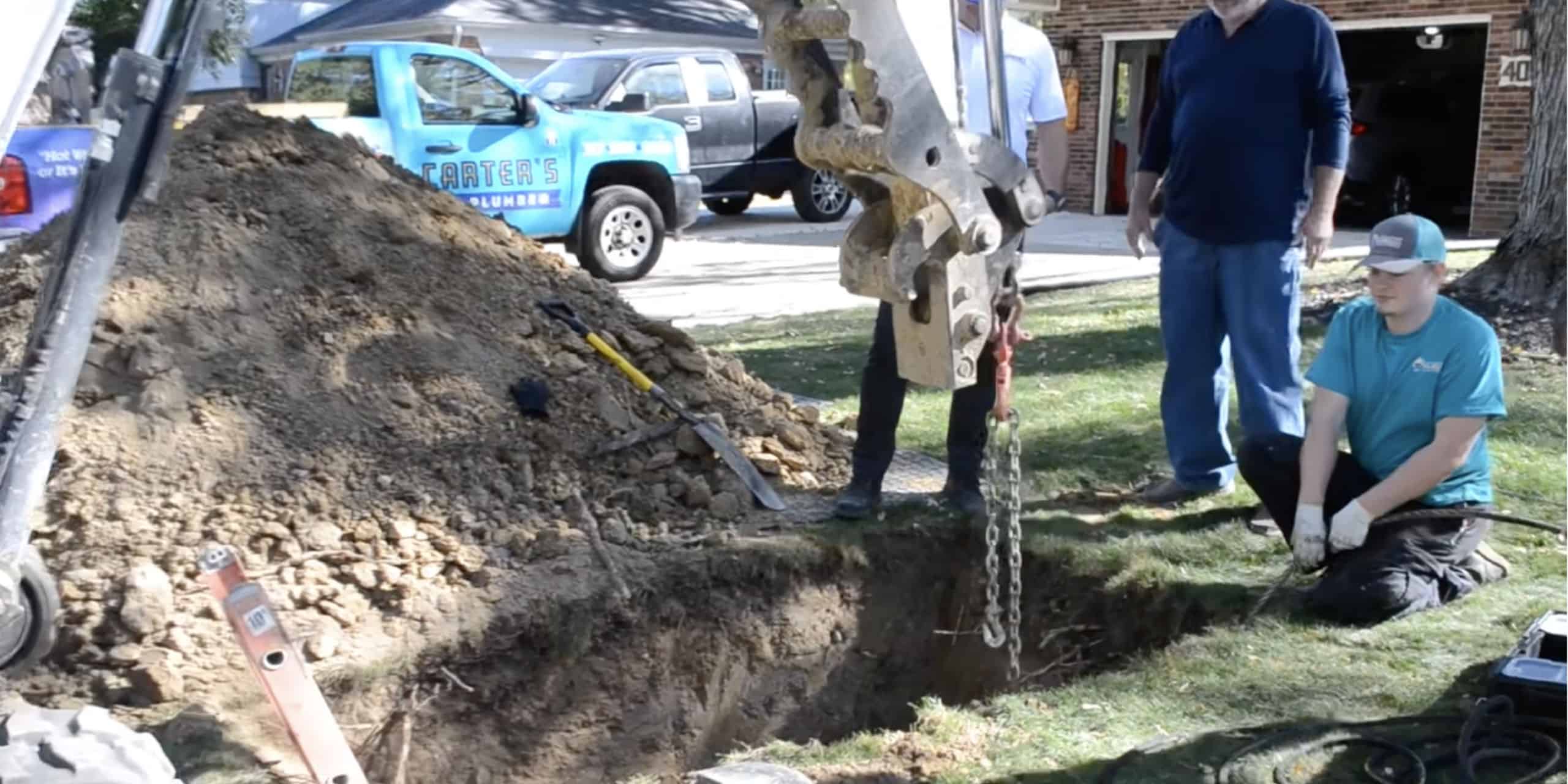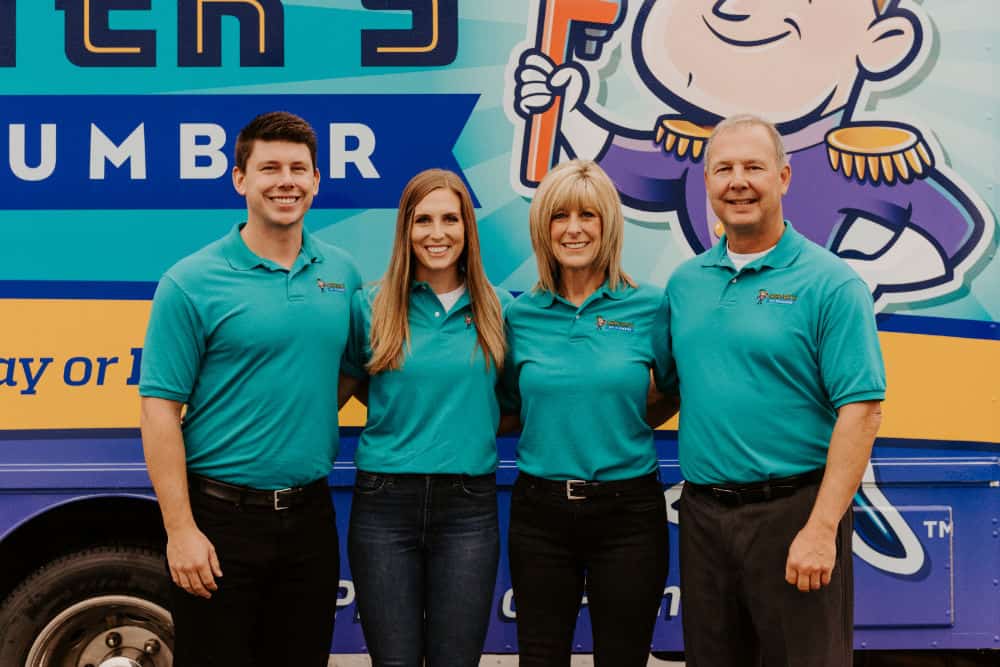Table of Contents
When sewer line repair problems arise in your home, the thought of costly plumbing services and yard damage can be overwhelming. For homeowners in Indianapolis facing this dilemma, understanding your options is crucial.
At Carter’s My Plumber, we pride ourselves on being trusted local experts in sewer line repairs–be they traditional or trenchless. This article breaks down the differences, pros, cons, costs, and other essential details to help you make an informed decision about sewer line replacement in Indianapolis area.

Traditional Sewer Line Repair: What It Entails
For decades, traditional sewer line repair has been the go-to method for pipe repair. It involves excavation; ultimately, digging trenches along the length of the damaged pipe to expose it for repair or replacement.
The Process
- A large trench is dug from the home to the city connection or the affected pipe section.
- The damaged pipe or pipe lining is removed or repaired.
- New pipe sections are installed.
- The trench is backfilled, and the surface restored.
Pros of Traditional Sewer Line Repair
- Full access and inspection: Excavation allows plumbers to see and assess the full extent of damage easily.
- Suitable for all types of damage: From collapsed sewer lines to misalignment, this method is versatile.
- Established method: Tried and true with a long history of success.
Cons of Traditional Sewer Repair
- Disruption: Digging trenches damages lawns, gardens, driveways, sidewalks, and sometimes even irrigation systems.
- Longer timelines: The digging, repair, and restoration process can take up to a week or longer.
- Higher restoration costs: Beyond plumbing, you may spend thousands repairing the plumbing system as well as landscaping or hardscapes.
- Messy and noisy: Heavy machinery and manual labor mean noise and dirt in your neighborhood.
Trenchless Sewer Repair: A Modern Alternative
Trenchless sewer repair in Indianapolis area is a newer technology that repairs or replaces sewer lines without extensive digging. Instead, it relies on specialized tools to access the pipe through small entry points.
Main Trenchless Methods
1. Pipe Lining (Cured-in-Place Pipe, or CIPP):
A resin-coated flexible liner is inserted inside the damaged pipe through a small access point. Once positioned, the liner is inflated and cured, creating a new, durable pipe inside the old one.
2. Pipe Bursting:
This technique involves pulling a bursting head through the existing pipe, breaking the old pipe apart while simultaneously pulling a new pipe into place. It replaces the pipe completely, often with new PVC piping.
Pros of Trenchless Sewer Repair
- Minimal disruption: Only small holes are dug, preserving your landscaping, driveways, and sidewalks.
- Faster completion: Many jobs finish in 1 to 2 days.
- Cost savings: Avoid costly restoration of yards and hardscapes.
- Durable results: New liners and pipes can last 50 years or more.
- Environmentally friendly: Less soil excavation means less waste and impact on your property.
Cons of Trenchless Sewer Repair
- Not suitable for all damage: Severe pipe misalignment, sagging (bellies), or improper slopes may require excavation.
- Initial cost: The upfront cost can be similar or sometimes higher than traditional repair, but savings on restoration usually offset this.
- Pipe lining reduces diameter: Since lining creates a pipe within a pipe, the internal diameter slightly decreases.
Comparing Costs: Upfront and Long-Term
Traditional sewer repair typically involves costs for:
- Excavation labor and equipment.
- Pipe replacement materials.
- Yard and hardscape restoration.
- Landscaping repairs (seeding, irrigation).
- Possible driveway or sidewalk repaving.
Trenchless repair costs include:
- Specialized equipment and materials (liners or bursting tools).
- Labor for minimal excavation.
- Inspection and preparation.
Cost Savings with Trenchless
While the upfront costs may be close, trenchless repair saves money by avoiding:
- Landscaping restoration.
- Hardscape repairs.
- Longer labor time due to extensive digging.
In many cases, trenchless repairs can be more cost-effective overall, especially if your yard or driveway has expensive features.
Time and Convenience: Which Method Fits Your Life?
When your sewer line fails, it’s not just a plumbing issue. Rather, it’s a huge disruption to your entire household. One of the biggest differences between traditional and trenchless methods is how much of your time (and peace of mind) each one consumes.
Traditional excavation can be a lengthy ordeal. Depending on the length and depth of the sewer line, as well as any complications beneath the surface (like tree roots, existing utility lines, or difficult soil conditions), the digging process alone might take several days. Add time for removing the old pipe, installing the new one, testing the system, and then restoring the property, and the project can easily stretch to a week or more.
In contrast, trenchless sewer repair is designed to be fast and efficient. Most projects can be completed within 1 to 2 days, sometimes even faster. Because it requires only one or two small access holes, there’s no need to spend time excavating your entire yard, or cleaning up afterward. There’s also no heavy equipment involved. That means your landscaping, hardscaping, and daily routines stay mostly intact.
For busy families or those working from home, trenchless repair offers a significantly more convenient experience. You can keep your driveway accessible, avoid long-term noise disruptions, and get your plumbing system back online with minimal interference in your daily life.
Impact on Your Home and Property
Traditional sewer line repairs require significant excavation, which can wreak havoc on your property. Large trenches cut through your lawn, leaving behind disturbed soil that’s difficult and costly to restore. Shrubs, flowerbeds, and other carefully cultivated landscaping may be uprooted or destroyed. Irrigation systems are often damaged during digging, requiring additional repairs. If your sewer line runs beneath a driveway or sidewalk, those surfaces may need to be broken up and replaced, adding both time and expense.
In contrast, trenchless sewer repairs require only one or two small access points. These entry holes are strategically placed and can be easily filled and patched once the work is complete.
Durability and Lifespan of Repairs
Traditional sewer repair involves physically removing the old, damaged pipe and replacing it with new materials; typically, PVC or cast iron. These materials are durable and well-tested, especially when the installation is done correctly.
Trenchless methods use different technologies to achieve the same goal: a strong, reliable sewer line with minimal surface damage.
Both trenchless and traditional methods, when installed by qualified professionals, offer long-term durability:
- Lifespans typically reach 50 years or more.
- The success of either method depends on proper preparation, quality materials, and experienced workmanship.
Ultimately, both approaches can deliver excellent results. The choice often comes down to the specific condition of your pipes and your priorities regarding yard preservation and timeline.
Environmental Considerations
Trenchless sewer repair is a more environmentally friendly option compared to traditional excavation. By minimizing the need to dig large trenches, this method reduces soil displacement and eliminates the need to remove and transport tons of earth. Fewer trucks on-site means lower fuel consumption and fewer carbon emissions. Additionally, less damage to lawns, trees, and plant beds helps preserve your home’s natural ecosystem.
In contrast, traditional sewer replacement generates far more waste–excavated soil, broken concrete, and debris–all of which often end up in landfills and require extensive restoration.
How to Choose the Right Pipe Repair Method for Your Home
Every home is different, and the best solution depends on your unique situation.
Here’s what to consider:
- Age and condition of your pipes
Older pipes made of clay or Orangeburg may be too deteriorated for lining or bursting. If your sewer line is misaligned or severely collapsed, excavation may be necessary. - Landscaping and driveway features
If your property has mature trees, gardens, or hardscaping like patios and concrete driveways, trenchless repair minimizes disruption. Avoiding damage to these features can save thousands in restoration costs. - Budget and timeline
While trenchless may have a similar or slightly higher upfront cost, it often ends up being more cost-effective. You avoid extensive yard repairs and get your plumbing back to normal faster. - Inspection results
A thorough camera inspection helps pinpoint the condition and alignment of the pipes. Carter’s My Plumber uses high-definition video to assess the sewer line and recommend the most effective, long-lasting solution.
Choosing the right method is easier when you work with experienced professionals. Our team will walk you through your options and help you make the best choice.
Why Choose Carter’s My Plumber for Your Sewer Repair in Indianapolis?
When your sewer line needs repair, you want a team you can trust… one that knows the local codes, understands the soil and infrastructure, and treats your home with care.
Carter’s My Plumber proudly serves the Indianapolis area with expert sewer repair solutions. Whether you need a traditional excavation or a modern trenchless approach, we tailor our service to your specific needs.
Here’s what sets us apart:
- We use state-of-the-art equipment for accurate diagnostics and repairs.
- Our pricing is clear, with detailed written estimates. There are no surprises.
- We work quickly and efficiently, minimizing disruption to your daily life.
- We hold all necessary Indianapolis licenses and certifications.
- We’re known as Indianapolis sewer line repair experts.
- Our commitment to customer satisfaction is backed by strong local reviews.
With Carter’s, you’re not just getting a repair, you’re getting peace of mind.
FAQs
What exactly is trenchless sewer line repair?
Trenchless repair replaces or rehabilitates damaged sewer lines with minimal digging, preserving your yard and driveway.
How does traditional sewer line repair differ?
Traditional repair involves excavating a trench to expose and replace damaged pipe sections, often causing significant yard damage.
Which sewer repair method is more expensive upfront?
Both methods can be similar in upfront cost. Trenchless may be cheaper overall due to less restoration work.
How long does trenchless sewer line repair take compared to traditional methods?
Trenchless repairs typically finish in 1–2 days; traditional repairs can take a week or more.
Can trenchless sewer repair methods handle all types of pipe damage?
Trenchless is ideal for cracks, corrosion, and pipe deterioration but not suitable for pipes with sagging or severe misalignment.
Does trenchless repair last as long as traditional methods?
Yes, trenchless repairs can last as long as, or longer than, traditional pipe replacements.
How much damage will trenchless sewer repair cause to my yard?
Minimal damage. Only small access holes are needed.
Are permits required for both trenchless and traditional repairs?
Yes, proper permits and certifications are required. Carter’s My Plumber holds all necessary local certifications.
What are the disadvantages of trenchless pipe lining?
The main disadvantage is a slight reduction in pipe diameter due to the liner thickness.
Is trenchless sewer repair worth it?
Absolutely, especially if you want to preserve your landscaping and minimize disruption.
What are the disadvantages of relining?
Relining doesn’t replace the old pipe; it creates a new pipe inside the existing one. If the old pipe has severe structural issues, pipe bursting or excavation may be better.



